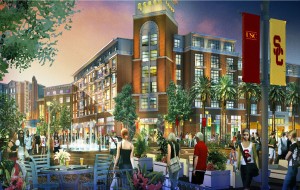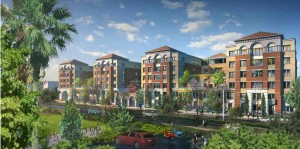It takes a village
Few universities in the country maintain as large of a community presence as USC does in South Los Angeles. With its 300-acre University Park Campus located in the heart of a bustling Downtown, its physical presence alone is enough to warrant attention, along with its attempts to act as a good neighbor to the surrounding communities.
Currently, USC is undergoing a planned transformation from the largely commuter school that it once was to a truly residential university. At the center of this change is the University Park Campus Master Plan, a 20-year outline of redevelopment and expansion for the university approved in 2008 under the direction of former President Steven B. Sample.
According to Kristina Raspe, associate senior vice president for university real estate and assessment management, the plan was created to ensure the physical growth of the university while accommodating the needs of the University Park community.
“The city asked us to provide a Master Plan to illustrate our planned growth for the next 20 years,” Raspe said. “We agreed that it was important for us to articulate our plan for the city and the surrounding community, as well as the students, faculty and staff.”
Included in the Master Plan is the construction of on-campus facilities such as the recently announced $70-million athletic facility that will be built on the site of the current intramural field.
An issue of greater contention for USC’s community, however, is the planned construction in what is known as Master Planning District 3, which consists of the area including University Village, Cardinal Gardens and Century Apartments.
“It was important to the community that we preserve a retail presence in that area,” Raspe said. “There was also a sense that students’ demand for housing was overrunning the neighborhood and displacing local residents, so the No. 1 issue that was raised by the community was the need for student housing.”
When USC began formulating ideas for the current Master Plan in 2006, university officials held several meetings with members of the community to include their input in the plans. Many neighbors expressed concern that the planned renovation of the University Village — an estimated $900-million undertaking that will produce graduate and undergraduate student housing, faculty offices, a new movie theater, stores and a parking garage — would be too upscale for the area. USC officials, however, have stressed that the new University Village will serve students as well as the community.
“Based upon the market analysis we’ve done, the new Village will not survive or be financially viable if at least 50 percent of our shoppers don’t come from the community,” Raspe said. “We are completely incentivized to fill the retail shops with retailers that are attractive to both the students and the neighbors from the local community.”
“The price point for the students very much overlaps the price point for the community,” she added.
“A lot of people think all of our students are high-end shopping, wealthy individuals, when in fact over 60 percent of our students are on some form of financial aid and very much enjoy shopping at places that are fiscally appropriate for community shoppers as well.”
In addition to worries of unaffordable retail overtaking the area, some local residents also feared that university expansion would encroach on the community.
“People are always worried about things like displacement, although a lot of it is based in past history and old fears,” said Shawn Simons, president of the North Area Neighborhood Development Council, an organization dedicated to involving local residents with development in the area. “With the Master Plan, USC doesn’t have plans to build on anything that isn’t already USC property, and that’s something that isn’t clear to a lot of people within the community.”
Redevelopment in the area stands to provide several benefits to the community, Simons said, and local residents are starting to become aware of those possibilities.
“The community was more focused on negatives that might happen rather than looking at the positives that it might bring,” Simons said. “Part of what NANDC has been doing is talking about the community benefits package and helping the community to have input on the massive amounts of money and infrastructure and jobs that this project can bring into our community.”
As the largest private employer in the City of Los Angeles, USC already brings a large amount of revenue to its community, whether through local hiring initiatives or attracting customers to local businesses. With the planned redevelopments, the local economy could be jumpstarted at a much-needed time.
“USC is a huge economic factor,” said Chris Pearson, policy director with the South L.A. Initiatives Program in the Mayor’s Office of Economic and Business Policy. “The biggest thing they have to embrace is providing the opportunity for the community members around them to benefit from the developments that are going to be happening in the coming years.”
Economic concerns have fueled much of the debate surrounding redevelopment in the area.
According to Eddie North-Hager, the USC staff representative on the NANDC, most of the issues brought up at the council’s community meetings revolve around these economic concerns, and most residents would welcome anything that improves their situations.
“Everybody’s a little bit worried about the future right now, in small ways and big ways,” he said. “It’s hard on this community, just like it is for everyone, but it was probably already harder on this community than it is in most places.”
The possibility of an economic rebirth being assisted by the university’s developments in the area embodies the Master Plan’s goal of improving the community while also expanding the university.
With such a possibility on the horizon, local opinion regarding the Master Plan has begun to change course from concern to optimism.
“This could bring an enormous amount of jobs to our community, a community that right now that has a median income of $26,000 a year,” Simons said. “If we’re able to bring real jobs to this community and our median income is able to go up by $10,000, that’s a huge change for our community.”
A major proponent of stimulating the economy within the community surrounding USC has been President C. L. Max Nikias, who has said he intends to create an initiative to help generate job growth in the area this spring.
Nikias also has other plans for the community. He’ has expressed interest in bringing free high-speed Internet to the 100 homes closest to campus and providing additional support to the schools USC partners with.
“We live in a community, and we live for a community,” Nikias said in a Nov. 9 discussion with students.
Though many local residents have sometimes expressed frustration with living in such close proximity to college students, they have also acknowledged that USC has always been a benefit to the community at large and will continue to be in the future.
“The school has to expand, and I think that they’re doing it responsibly,” said David Martinez, a resident who lives among student housing on 29th Street. “The community has to adapt to the school, just as the school has to adapt to the community. It’s a two-way street.”
Simons agreed that the community and the university will have to work together and reconcile their differences in order for legitimate improvement to come to the neighborhood.
“It’s important that the community continues to get involved and make their voices heard in terms of what’s important to them,” Simons said. “Change is definitely going to come, but we have an opportunity to focus the change.”
Until such change does manifest itself in South Los Angeles, students, faculty and community members alike will all have to focus on living together in the current situation. As USC continues with its Master Plan, officials said the community is sure to play a large role.
“Even in the current University Village, as much as it’s a product of the 1960s, students who go to USC, students who go to local high schools, and moms and dads who use the grocery store all come here and they eat together,” North-Hager said. “That’s the perfect picture of coexisting in the community.”





Yes, of course the university is partners with the city and most importantly with our surrounding community–I don’t think any school does more for its community than USC does. Both benefit immensley from this symbiosis.
At the same time, the present administation has an OBLIGATION to the present and to the future trojan community to secure physical space north of Jefferson, above and beyond the present land owned by the university, in order to provide for growth over the coming decades. One hundred years from now, the campus will surely look much different, aside from our UPC core campus, than it does today. Specifically, the only sensible area for physical expansion is into the area between Hoover and Figueroa and Adams and Jefferson. USC will undeniabley require sites for future buildings and athletic fields to service its 35,000 strong student population. It would be negligant not the plan for growth beyond the warren that will soon be University Village/Century/Cardinal Gardens. Letting outside developers like University Gateway determine the economies of USC makes no sense–this is the universities responsibility.